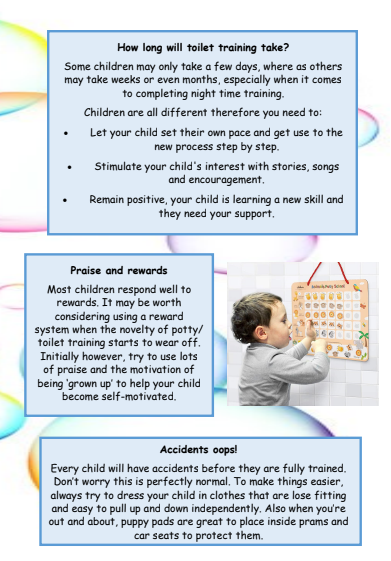Toilet training information for Parents and Carers
- May 21, 2024
- 3 min read
If you cannot view the attached booklet, please continue to read this article as all of the information can be found in this article!
Kindly shared by Dingley's Promise, produced by Hulme, Moss side and Rusholme school readiness sub group, please read over the above booklet to learn more! Is my child ready? There is no set age at which a child is ready for toilet training, but most children gain the skills they need to start training between the age of 18 months and 3 years old. Your child is probably ready to toilet train if
They show an interest in the bathroom
They show a desire for independence
They are able to follow simple instructions and requests such as 'Do you need a wee?' or 'where's the toilet?'
They have a dry nappy for 2 hours or more at a time
They show signs of discomfort when their nappy is wet or soiled
They show awareness that they are having a wee or poo
They can pull their own trousers up and down with very little help
They may even begin to tell you that they need a wee or a poo before they do it
How long will toilet training take? Some children may only take a few days, where as others may take weeks or even months, especially when it comes to completing night time training. Children are all different therefore you need to:
Let your child set their own pace and get use to the new process step by step
Stimulate your child's interest with stories, songs and encouragement
Remain positive, your child is learning a new skill and they need your support
Praise and rewards
Most children respond well to rewards! It may be worth considering using a reward system when the novelty of potty/training starts to wear off. Initially however, try to use lots of praise and the motivation of being 'grown up' to help your child become self-motivated.
Accidents oops!
Every child will have accidents before they are fully trainied.Don’t worry this is perfectly normal. To make things easier, always try to dress your child in clothes that are lose fitting and easy to pull up and down independently. Also when you’re out and about, puppy pads are great to place inside prams and car seats to protect them.
Potty's
Toddlers often prefer to use a potty instead of the toilet. When choosing a potty, check it’s the right size and comfortable to sit on. The toilet may initially feel too big and your child may be afraid of falling in. Alternatively, you may wish to purchase a child’s toilet seat which sits on top of you’re existing toilet and a toilet step to help you’re child to reach and sit more comfortably.
Nursery
Toilet training should always begin at home first. When you start toilet training with your child, make sure you work in partnership with your child’s nursery. Let them know how it’s going at home and exactly what you are doing so they can support in the best way possible. Always provide plenty of spare clothes, children are very likely to have accidents throughout the day. Finally, please don’t worry if your child has more accidents at nursery than at home, they will need time, encouragement and lots of reassurance until they are fully trained.




















Comments